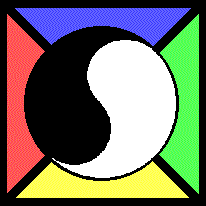TAOISM

"Be still like a mountain and flow like a great river." Lao Tze.
History of Taoism
Tao can be roughly translated into English as path. The founder of Taoism was Lao-Tse
(604-531 BCE), a contemporary of Confucius. He was searching for a way that would avoid
the constant feudal warfare and other conflicts that disrupted life during his lifetime.
The result was his book: Tao-te-Ching
Taoism started as a combination of psychology and philosophy but evolved into a religion
in 440 CE when it was adopted as a state religion. At that time Lao-Tse became popularly
venerated as a deity.
It, along with Buddhism and Confucianism, became the three great religions of China. Taoism
currently has about 20 million followers, and is primarily centered in Taiwan. About
30,000 Taoists live in North America; 1,720 in Canada (1991 census).
Taoist Beliefs and Practices:
- Tao is the first-cause of the universe. It is a force that flows through all life.
- Time is cyclical, not linear as in Western thinking
- Yin (dark side) is the breath that formed the earth. Yang (light side) is the breath
that formed the heavens.
- They symbolize pairs of opposites which are seen throughout the universe, such
as good and evil, light and dark, male and female. Intervention by human civilization upsets the balances of
Yin and Yang. The
symbol of Taoism, seen at the top of this page, represents Yin and Yang in balance.
- "The Tao surrounds everyone and therefore everyone must listen to find enlightenment."
- Five main organs and orifices of the body correspond to the five parts of the sky:
water, fire, wood, metal and earth.
- Each person must nurture the Ch'i (air, breath) that has been given to them.
- The goal of everyone is to become one with the Tao.
- Development of virtue is one's chief task. The Three Jewels to be sought are
compassion, moderation and humility.
- Taoists follow the art of "wu wei", which is to achieve action through minimal action.
"It is the practice of going against the stream not by struggling against it and thrashing
about, but by standing still and letting the stream do all the work. Thus the sage knows
that relative to the river, he still moves against the current. To the outside world
the sage appears to take no action - but in fact he takes action long before others ever
foresee the need for action."
- One should plan in advance and consider carefully each action before making it.
- A Taoist is kind to other individuals, largely because such an action tends to be
reciprocated.
- Taoists believe that "people are compassionate by nature...left to their own
devices [they] will show this compassion without expecting a reward."
Tai Chi
There is a long history involvement by Taoists in various exercise and movement techniques.
Tai chi in particular works on all parts of the body. It "stimulates the central nervous
system, lowers blood pressure, relieves stress and gently tones muscles without strain. It also
enhances digestion, elimination of wastes and the circulation of
blood. Moreover, tai chi's
rhythmic movements massage the internal organs and improve their functionality." Traditional
Chinese medicine teaches that illness is caused by blockages or lack of balance in the body's
"chi" (intrinsic energy). Tai Chi is believed to balance this energy flow.
Taoist Texts
These include:
Tao-te-Ching ("The Way of Power," or "The Book of the Way") is believed to have been
written by Lao-Tse. It describes the nature of life, the way to peace and how a ruler
should lead his life.
Chuang-tzu (named after its author) contains additional teachings.

